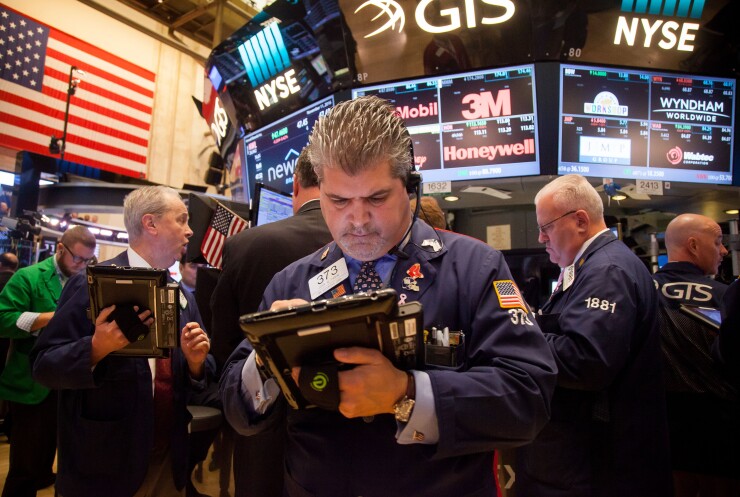
The labor market revival in November did not on its own deter another interest-rate cut this week — welcomed news for lenders — but bank investors nonetheless tapped the brakes after the latest federal jobs report, preferring to wait for Wednesday's inflation data.
The KBW Nasdaq Bank Index was flat on Friday after the Labor Department said the U.S. job market bounced back last month. The index eased on Monday and traded in a narrow range on Tuesday as investors waited to pair the employment data with an updated read on inflation. Bank stocks are
U.S. employers added
Still, average hourly earnings in November rose by 13 cents, or 0.4%, to $35.61. Over the past 12 months, wages increased by 4%, exceeding the latest reading on the annual inflation rate — 2.6% in October.
"The inflation fire has not been put out, with core consumer price increases still elevated and another pop in wages," said Chris Rupkey, chief economist at FwdBonds.
As such, before diving back into rally mode, bank investors want assurances that the Labor Department's
"CPI will be a potential market mover," said Chris Nichols, director of capital markets at SouthState Bank in Winter Haven, Florida.
The Federal Reserve's decision on a
The recent run of high borrowing costs made a big impact without the feared side effect of tilting the economy into recession. The U.S. gross economy expanded at a 2.8% annual rate in the third quarter, following growth in the first half of the year, according to federal data.
After the latest jobs report, the
Still, inflation remains well above the Fed's preferred long-term level of 2%. That is the level at which the economy can grow steadily without price shocks, officials say.
Earlier this month, Fed Chair Jerome Powell said the economy's enduring vigor gives policymakers the ability to be patient on rate decisions. Other Fed officials have said they anticipate additional interest-rate cuts, though they emphasized these were subject to changes in economic data, notably including inflation readings.
This is why bank investors are cautious this week, Nichols said.
Inflation reached a 40-year high in June 2022 at 9.1%. This developed in the aftermath of the coronavirus pandemic and the supply-chain snarls it created. Russia's invasion of Ukraine also upended global energy markets in 2022 and sent oil and gas prices surging, compounding matters.
The Fed had boosted rates 11 times from March 2022 to mid-2023, driving borrowing costs higher, curbing spending and helping to curtail overall prices.Yet this also crimped loan demand and hindered banks' growth last year and through the
Median sequential
The Fed's actions also pushed up the interest rates that banks pay for deposits. When this happened, the difference between what banks pay for deposits and earn on loans — known as net interest margin — contracted. Shrinking margins tend to hurt banks' bottom lines because many rely heavily on the income they earn from lending.
"Obviously, a lot of expectations hinge on more rate cuts," said Michael Jamesson, a principal at the bank consulting firm Jamesson Associates.
He noted that, ahead of December, bank stocks had mounted a fall rally in the wake of the presidential election. This was in part due to Trump's deregulation vows that could spur business investment — and borrowing — and potentially pave a path for more bank M&A. The Biden administration imposed more scrutiny on dealmaking and M&A slowed in recent years. But rate-cut expectations were also key, he said.
The median total return in November for the 211 bank stocks in an S&P analysis was 13.4%, surpassing the S&P 500's 5.9% return.





